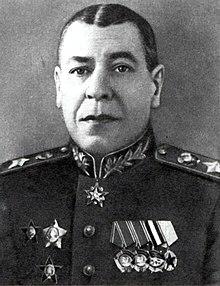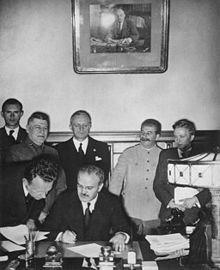Boris Shaposhnikov | |
|---|---|
 Boris Mikhailovitch Shaposhnikov | |
| Native name | Russian: Бори́с Ша́пошников |
| Birth name | Boris Mikhailovitch Shaposhnikov |
| Born | October 2, 1882 Zlatoust, Ufa Governorate Russian Empire |
| Died | March 26, 1945 (aged 62) Moscow, Soviet Union |
| Buried | |
| Allegiance | |
| Years of service | 1901–1945 |
| Rank | Colonel (Imperial Army) Marshal of the Soviet Union (Red Army) |
| Commands held | Leningrad Military District Moscow Military District Chief of the General Staff Volga Military District |
| Battles/wars | World War I Russian Civil War World War II |
| Other work | Mozg Armii (The Brain of the Army), 1929 |
Boris Mikhaylovich Shaposhnikov (Russian: Бори́с Миха́йлович Ша́пошников) (October 2 [O.S. September 20] 1882 – March 26, 1945) was a Soviet military commander, Chief of the Staff of the Red Army, and Marshal of the Soviet Union.
Biography
Shaposhnikov, born at Zlatoust, near Chelyabinsk in the Urals, had Orenburg Cossack origins.[1] He joined the army of the Russian Empire in 1901 and graduated from the Nicholas General Staff Academy in 1910, reaching the rank of colonel in the Caucasus Grenadiers division in September 1917 during World War I.[2] Also in 1917, unusually for an officer of his rank, he supported the Russian Revolution, and in May 1918 joined the Red Army.[2]
Shaposhnikov was one of the few Red Army commanders with formal military training, and in 1921 he became 1st Deputy Chief of Staff of the Army's General Staff, where he served until 1925. He was appointed commander of the Leningrad Military District in 1925 and then of the Moscow Military District in 1927. From 1928 to 1931 he served as Chief of the Staff of the Red Army, replacing Mikhail Tukhachevsky, with whom he had a strained relationship.[3] He was then demoted to command of the Volga Military District from April 1931 to 1932 as a result of slanderous accusations of belonging to a clandestine organization by an arrested staff officer.[2] In 1932 he was appointed commandant of the Red Army's Frunze Military Academy, then in 1935 returned to the command of the Leningrad region. In 1937 he was appointed Chief of the General Staff, in succession to Alexander Ilyich Yegorov, a victim of a Case of Trotskyist Anti-Soviet Military Organization secret trial during Joseph Stalin's Great Purge of the Red Army. In May 1940 he was appointed a Marshal of the Soviet Union.[4]
Despite his background as a Tsarist officer, Shaposhnikov won the respect and trust of Stalin. Due to his status as a professional officer, he did not join the Communist Party until 1939.[5] This may have helped him avoid Stalin's suspicions. The price he paid for his survival during the purges was collaboration in the destruction of Tukhachevsky and many other colleagues. Stalin showed his admiration for the officer by always keeping a copy of Shaposhnikov's most important work, Mozg Armii (Мозг армии, "The Brain of the Army") (1929), on his desk.[6] Shaposhnikov was one of the few men whom Stalin addressed by his Christian name and patronymic.[5][7] Mozg Armii has remained on the curriculum of the General Staff Academy since its publication in 1929.[8]
Fortunately for the Soviet Union, Shaposhnikov had a fine military mind and high administrative skills.[9] He combined these talents with his position in Stalin's confidence to rebuild the Red Army leadership after the purges. He obtained the release from the Gulag of 4,000 officers deemed necessary for this operation. In 1939 Stalin accepted Shaposhnikov's plan for a rapid buildup of the Red Army's strength. Although the plan was not completed before the German invasion of June 1941, it had advanced sufficiently to save the Soviet Union from complete disaster.[10]

Shaposhnikov planned the 1939 invasion of Finland, but was much less optimistic about its duration than Stalin and the campaign's commander Kliment Voroshilov.[11] This Winter War (1939-1940) did not deliver the immediate success the Soviet side had hoped for, and Shaposhnikov resigned as Chief of the General Staff in August 1940, due to ill health and to disagreements with Stalin about the conduct of that campaign.[4][5] Following the German invasion, he was reinstated (29 July 1941) as Chief of the General Staff[5] to succeed Georgy Zhukov,[4] and also became Deputy People's Commissar for Defence, the post he held until his career was cut short by ill-health in 1943. He resigned again as Chief of the General Staff due to ill-health on 10 May 1942.[5] He held the position of commandant of the Voroshilov Military Academy until his death in 1945. Shaposhnikov had groomed his successor as Chief of Staff, Aleksandr Vasilevsky, and remained an influential and respected advisor to Stalin until his death.[4][5]
Honours and awards
- Order of St. Anna, 4th class (26 October 1914), 3rd class with Swords and Bow (1915), 2nd class with Swords (1 November 1916)
- Order of St. Vladimir, 4th class with Swords and Bow (2 November 1914)
- Order of Saint Stanislaus, 3rd class with Swords and Bow (22 July 1916)
 Soviet Union
Soviet Union
- Three Orders of Lenin (31 December 1939, 3 October 1942, 21 February 1945)
- Order of the Red Banner, twice (14 October 1921, 3 November 1944)
- Order of Suvorov, 1st class (22 February 1944)
- Order of the Red Star, twice (15 January 1934, 22 February 1938)
- Jubilee Medal "XX Years of the Workers' and Peasants' Red Army" (22 February 1938)
- Medal "For the Defence of Moscow" (1 May 1944)
See also
- Russian destroyer Marshal Shaposhnikov (BPK 543)
References
Citations
- ^ A. Shishov. 100 Great Cossacks http://fisechko.ru/100vel/kazakov/91.html
- ^ a b c Smele 2015, p. 1012.
- ^ Samuelson & Shlykov 2000, p. 98.
- ^ a b c d Wells 2013, p. 287.
- ^ a b c d e f Glantz & House 2009, p. 38.
- ^ The Journal of Historical Review: 1996-1997, Volume 16 1996, p. 28.
- ^ Radzinsky 2011, p. 472.
- ^ Aldis & McDermott 2000.
- ^ The Journal of Historical Review 1996-1997, Volume 16 1996, p. 28.
- ^ Ringer 2006, p. 143.
- ^ Kulkov, Rzheshevskii & Shukman 2014, p. xxv.
Bibliography
- Aldis, Anne C.; McDermott, Roger N., eds. (2004). Russian Military Reform, 1992-2002. Routledge. ISBN 978-1-1357-5468-6.
- Glantz, David M.; House, Jonathan (2009). To the Gates of Stalingrad: Soviet-German Combat Operations, April-August 1942. Lawrence, Kansas: University Press of Kansas. ISBN 978-0-7006-1630-5.
- Kulkov, E. N.; Rzheshevskii, Oleg Aleksandrovich; Shukman, Harold (2014). Stalin and the Soviet-Finnish War, 1939-1940. Routledge. ISBN 978-1-1352-8294-3.
- Radzinsky, Edvard (2011). Stalin: The First In-depth Biography Based on Explosive New Documents from Russia's Secret Archives. Knopf Doubleday Publishing Group. ISBN 978-0-3077-5468-4.
- Ringer, Ronald E. (2006). Excel HSC Modern History. Pascal Press. ISBN 978-1-7412-5246-0.
- Samuelson, Lennart; Shlykov, Vitaly (2009). Plans For Stalin's War Machine: Tukhachevskii and Military-Economic Planning, 1925-1941. Palgrave Macmillan. ISBN 978-0-3122-2527-8.
- Smele, Jonathan D. (2015). Historical Dictionary of the Russian Civil Wars, 1916-1926: Volume 2 of Historical Dictionaries of War, Revolution, and Civil Unrest. Rowman & Littlefield. ISBN 978-1-4422-5281-3.
- Wells, Anne Sharp (2013). Historical Dictionary of World War II: The War against Germany and Italy: Historical Dictionaries of War, Revolution, and Civil Unrest. Scarecrow Press. ISBN 978-0-8108-7944-7.
- "The Journal of Historical Review: 1996-1997, Volume 16". The Journal of Historical Review. The University of Wisconsin - Madison: Institute for Historical Review. 1996.
External links
- Newspaper clippings about Boris Shaposhnikov in the 20th Century Press Archives of the ZBW
| Military offices | ||
|---|---|---|
| Preceded by Mikhail Tukhachevsky | Chief of the Staff of the Red Army May 1928 – April 1931 | Succeeded by Vladimir Triandafillov |
| Preceded by Alexander Yegorov | Chief of the Staff of the Red Army 10 May 1937 – August 1940 | Succeeded by Kirill Meretskov |
| Preceded by Georgy Zhukov | Chief of the Staff of the Red Army 29 July 1941 – 11 May 1942 | Succeeded by Aleksandr Vasilevsky |
._1921.jpg)